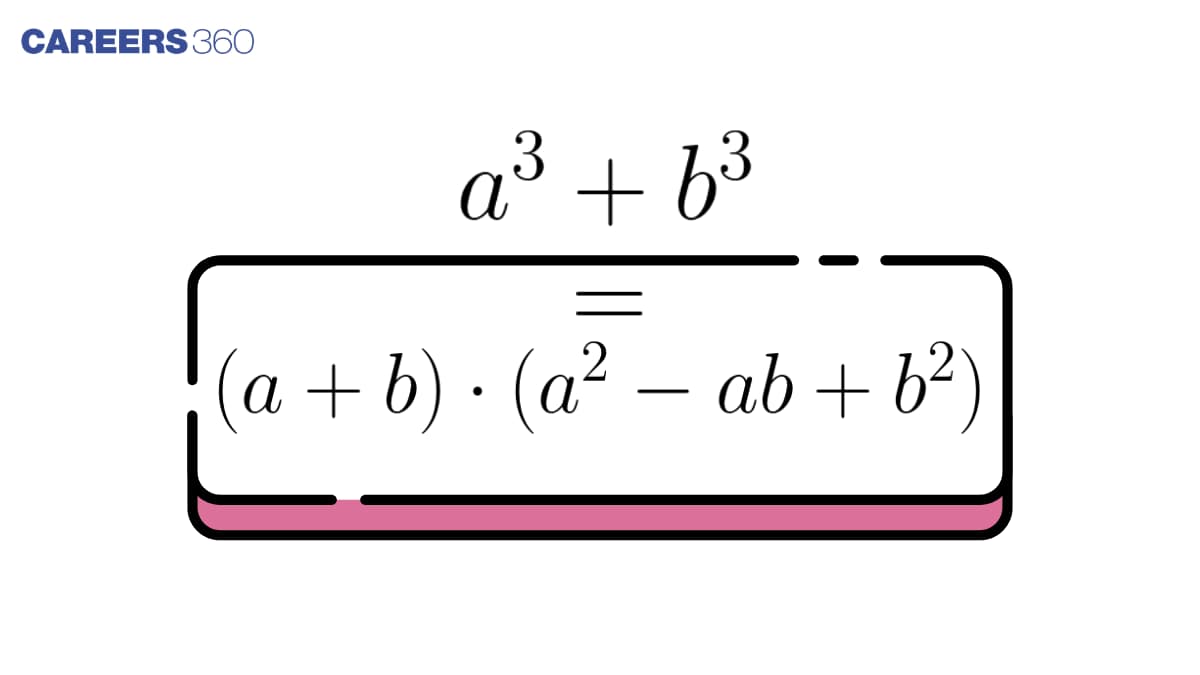A Cube Plus B Cube Formula | a^3 + b^3 Formula
Algebra is one of the fundamental concept in mathematics. Algebra is of the main concpets which helps in solving complex algebraic equations within no time. In this article, we will discuss about another such useful identity that makes the process of calculating cubes of numbers very easy. We will learn about what is a cube plus b cube formula along with various examples for better understanding.
JEE Main: Study Materials | High Scoring Topics | Preparation Guide
JEE Main: Syllabus | Sample Papers | Mock Tests | PYQs

A cube plus B cube Formula
The $a^3+b^3$ formula is also known as the sum of cubes (of two numbers) formula, widely used to find the sum of cubes of 2 numbers when we do not know their real values. It has various applications in factorization also.
Formula of a cube plus b cube is expressed as : a cube plus b cube is equals to :
$a^3+b^3=(a+b)\left(a^2-a b+b^2\right)$

Identity of a Cube plus b Cube
Now, let us verify a cube plus b cube formula.
$
\text { LHS }=a^3+b^3
$
When we simplify RHS side we get,
$
=(a+b)\left(a^2-a b+b^2\right)
$
Now we multiply $a$ and $b$ separately with $\left(a^2-a b+b^2\right)$ we get
$
\begin{aligned}
& =a\left(a^2-a b+b^2\right)+b\left(a^2-a b+b^2\right) \\
& =a^3-a^2 b+a b^2+a^2 b-a b^2+b^3 \\
& =a^3-a^2 b+a^2 b+a b^2-a b^2+b^3 \\
& =a^3-0+0+b^3 \\
& =a^3+b^3
\end{aligned}
$
Examples on a cube plus b cube formula
Example 1: Find the value of $105^3+7^3$ by using the formula of a cube plus b cube.
Solution: To find: $105^3+7^3$.
We assume that $\mathrm{a}=105$ and $\mathrm{b}=7$.
Substituing values, a cube plus b cube is equal to :
$
\begin{aligned}
& a ^3+b^ 3=(a+b)(a ^2-a b+b ^2) \\
& 105^3+7^3=(105+7)(105^2-(105)(7)+7^2) \\
& =(112)(11025-735+49) \\
& =(112)(10339) \\
& =1157968
\end{aligned}
$
Example 2: Factorize the expression $125x^3+27$ by using a cube plus b cube identity.
Solution: To factorize: $125x^3+27$.
We will use the formula for a cube plus b cube to factorize this.
We write the given expression as a cube plus b cube equals to :
$
125x^3+27=(5x)^3+3^3
$
We will substitute $a=5x$ and $b=3$ in the formula of a cube plus b cube.
$
\begin{aligned}
& a^3+b^3=(a+b)(a^2-ab+b^2) \\
& (5x)^3+3^3=(5x+3)((5x)^2-(5x)(3)+3^2) \\
& =(5x+3)(5x^2-15x+9)
\end{aligned}
$
Example 3 : Simplify $29^3+30^3$ using a cube plus b cube formula.
Solution: To find $29^3+30^3$
Let us assume $\mathrm{a}=29$ and $\mathrm{b}=30$
A cube plus B cube is equal to : $a^3+b^3=(a+b)(a^2-ab+b^2)$
We substitute these in the a cube plus b cube identity.
$
\begin{aligned}
& a^3+b^3=(a+b)(a^2-ab+b^2) \\
& 29^3+30^3=(29+30)(29^2-(29)(30)+30^2) \\
& =(59)(841-870+900) \\
& =(59)(871) \\
& =51389
\end{aligned}
$
Example 4: Factor $y^3$ + 125.
Solution: $\mathrm{y}^3+125$ can be written as $\mathrm{y}^3+5^3$
Now, $\mathrm{y}^3+5^3$ is in the form of $\mathrm{a}^3+\mathrm{b}^3$.
Using the a cube plus b cube identity, $a^3+b^3=(a+b)(a^2-ab+b^2)$, we get,
$
\begin{aligned}
& y^3+5^3=(y+5)(y^2-5y+5^2) \\
& y ^3+5^3=(y+5)(y^2-5y+25)
\end{aligned}
$
Example 5: Factor the expression $27x^3+8$.
Solution: $27x^3+8$ can be written as $(3x)^3+2^3$
On comparing with formula of a cube plus b cube, we get $\mathrm{a}^3+\mathrm{b}^3=(\mathrm{a}+\mathrm{b})(\mathrm{a}^2-\mathrm{ab}+\mathrm{b}^2)$, we have; $\mathrm{a}=3 \mathrm{x}$ and $\mathrm{b}=2$
Therefore, $(3x)^3+2^3=(3x+2)[(3x)^2-(3x) \cdot(2)+2^2]$ (using a cube plus b cube formula)
$
27x^3+8=(3x+2)[9x^2-6x+4]
$
List of Topics Related to A cube plus B cube Formula
Frequently Asked Questions (FAQs)
A cube plus B cube formula, or the factors of a cube plus b cube, $a^3+b^3=(a+b)(a^2-ab+b^2)$.
A cube plus B cube plus C cube formula is given by, $a^3+b^3+c^3=(a+b+c)(a^2+b^ 2+c^2-ab-bc-ca)+$ 3abc.
A cube minus B cube is equal to $(a-b) (a^2 + ab + b^2)$.
A cube plus b cube equals to $(a + b) (a^2 - ab + b^2)$.
A cube plus B cube equals to $(a+b)(a^2-ab+b^2)$.
Also Read
20 Jan'25 04:04 PM
20 Jan'25 03:52 PM
20 Jan'25 03:28 PM
20 Jan'25 02:14 PM
20 Jan'25 02:00 PM
12 Feb'24 04:54 PM
29 Jan'24 05:47 PM
29 Jan'24 05:26 PM
28 Jan'24 09:42 PM